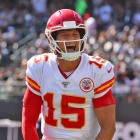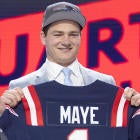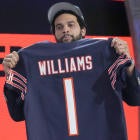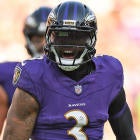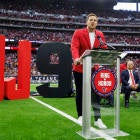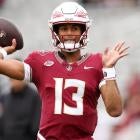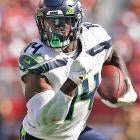More and more in recent seasons, it's become clear that the most important thing in the modern NFL is offensive infrastructure. Offense has been more important than defense for a while now, and the personnel involved in crafting that offense matters a great deal when it comes to determining its success.
Who is your quarterback? Who is protecting him? Who does he throw to? Who does he have next to him in the backfield? Who's scheming those players open? All the pieces matter. The degree to which they matter varies greatly, of course, but each plays a role in making an offense hum at peak efficiency.
All of this brings us to the following project: ranking the offensive infrastructure of all 32 NFL teams. To go about this, we used a weighted grading system where each team was given a 1-5 ranking (1 = terrible, 5 = elite) in the following areas: Quarterback, Offensive Line, Pass-Catchers (WR/TE), Running Backs, and Play-Caller (head coach or offensive coordinator).
Those scores were then weighted so that quarterback was the most important component of the offense, followed by offensive line, play-caller, pass-catchers, and then finally running backs, so that the weights reflected as closely as possible the reality of the way modern NFL offenses really work. We'll run through these rankings in this space over the next few days. Earlier this week we began by examining the lowest-ranking tier in the NFL, the teams with below-average overall units, and the teams whose offenses should be good but might be missing one piece or another that could keep them from being elite. Today, we'll finish things up with the five teams whose offenses -- assuming good health -- should be among the best in the league, unless something goes seriously wrong.
Who'll be the biggest names in next year's free agent class? Will Brinson and the Pick Six Podcast Superfriends break down that, the latest on the 2020 draft and much more; listen below and be sure to subscribe for daily NFL goodness.
5. Dallas Cowboys (4.33)
Grades: QB: 4, OL: 5, Play-caller: 4, WR/TE: 4, RB: 5, Total: 22
Had Dak Prescott not had a late-season hiccup, he might have garnered an elite grade in this system. Despite that bump, however, Prescott is still coming off a campaign where he was an MVP candidate for about three-quarters of the year, and ended up throwing for a career-high 4,902 yards and 30 touchdowns. He also adds a ton of value with his legs, as he has rushed for at least 275 yards and three touchdowns in each of his four NFL seasons. To put that in proper perspective, here's the list of post-merger quarterbacks with at least four such seasons in their entire career: Prescott, Cam Newton, Randall Cunningham, Steve Young, Steve McNair, Daunte Culpepper, Kordell Stewart, Michael Vick, and Russell Wilson. That's it. And Prescott is four for four so far. If he does it again next season (a reasonable expectation, especially considering he ran for six scores in each of his first three years), he'll be only the fifth player ever to have five such seasons. In other words, he is quite good, even if not yet consistently elite.
Prescott has the good fortune of working behind one of the NFL's best offensive lines, and that should remain the case even after the retirement of Travis Frederick. Joe Looney did an admirable job filling in for Frederick two years ago, and is a capable replacement should the Cowboys tab him for the role. But they also foresaw the potential of not having Frederick somewhere down the line and selected Connor McGovern in the third round of last year's draft, and it's possible he slides into the center position. Throw in perennial All-Pros Tyron Smith and Zack Martin, plus an improved La'el Collins, and this is still one of the NFL's best units up front.
Offensive coordinator and play-caller Kellen Moore is still in place even after the Cowboys switched over from Jason Garrett to Mike McCarthy, and that continuity should help Prescott and company make the transition to the rest of the new coaching staff. Marrying Moore's play-action and RPO-heavy offense with McCarthy's more pass-oriented approach should help make the Cowboys a more efficient offense. In Amari Cooper and Michael Gallup, Dallas has one of the NFL's best wide receiver duos, and the underrated Blake Jarwin is an improvement over what was left of Jason Witten at the tight end spot last year.
Dallas still needs to find a replacement for Randall Cobb in the slot, but this is one of the deepest wide receiver drafts in years and they also have Tony Pollard, who was a hybrid receiver and running back in his college days and is dynamic enough that the Cowboys should find a way to manufacture more touches for him. Among all running backs with at least 80 carries last season, Pollard led the entire league in Pro Football Focus' elusive rating, showcasing his ability to make defenders miss in open space. And of course, he is not even the team's lead back, with Ezekiel Elliott once again in line to carry the ball-carrying load.
T-3. San Francisco 49ers (4.53)
Grades: QB: 4, OL: 5, Play-caller: 5, WR/TE: 4, RB: 5, Total: 23
Everything we wrote about the 49ers' offense prior to the Super Bowl still stands:
How did this team manage to turn inefficient plays into efficient ones? Through a combination of personnel, play-design, and a commitment to fakery that surpasses that of anybody else in the league.
The personnel part is the easiest to explain. It starts up front, with stalwart left tackle Joe Staley, 2018 first-rounder Mike McGlinchey, and the combination of Laken Tomlinson, Mike Person, and both Weston Richburg and his injury replacement Ben Garland on the inside. That group was the fifth-best run-blocking unit in the league this season, per Pro Football Focus, and they received assistance from arguably the best blocking fullback (Kyle Juszczyk) and tight end (George Kittle) in the whole league.
Those guys cleared the way for a stable of running backs that might be the fastest in the NFL. NFC title game hero Raheem Mostert ran the 40-yard dash in 4.31 seconds. Free-agent signee Tevin Coleman, who gained extensive experience in head coach Kyle Shanahan's offense during their time together in Atlanta, ran it in 4.39 seconds. And after running 4.48 seconds at the combine, Matt Breida ran it in 4.38 seconds at his pro day. These guys can scoot.
The design of Shanahan's zone-based running schemes allows those backs to gather a full head of steam as they make their way through holes in the line of scrimmage, picking up chunk gains in the process. And while the marriage of scheme and players is perfect, the Niners complement that marriage with a cavalcade of shifts and motions and fakes intended to confuse the defense about where the ball actually is, who has it, and where it's going.
The 49ers are one of the very few teams in the NFL that make running the ball an efficient option (more on another of those teams in a minute), and it helps out every other part of their offense. Jimmy Garoppolo doesn't have the type of ceiling that the quarterbacks of the other offenses on this list possess, but because of the way Shanahan designs his offense, he doesn't need it. All he needs to do is play point guard and get the ball to his playmakers, letting them do the work. San Francisco will need to find a replacement for Emmanuel Sanders, but A. as mentioned, this is an incredibly deep draft for receivers; and B. they'll also have the ability to work in the dynamic Jalen Hurd after he missed all of last season due to injury.
T-3. New Orleans Saints (4.53)
Grades: QB: 4, OL: 5, Play-caller: 5, WR/TE: 4, RB: 5, Total: 23
We got an up close and personal look at just how excellent the Saints' offensive infrastructure was just last season, when they lost Drew Brees for five weeks and Alvin Kamara for two (while playing injured for several others) and they barely missed a beat. Brees remains a remarkably accurate and efficient passer, and the only thing keeping him from an elite grade his is his advancing age, which has led to sub-par late-season performances in the recent past and also keeps him from challenging defenses downfield with as much consistency as you'd like to see.
The marriage of Brees' accuracy, Sean Payton's offensive design, and the combination of Kamara and Michael Thomas, however, all but ensures an efficient offense. Kamara excels at making defenders miss both as a runner and a receiver out of the backfield. Thomas is an enormous target with instructional-video-perfect route-running skills and velcro hands, and he and Brees are in 100 percent lockstep on short and intermediate passes. They're so automatic on those throws that they might as well be hand-offs, but they gain about twice as many yards as the average run. With that duo as the basis of the offense, the floor for New Orleans is incredibly high.
It helps to have an excellent offensive line keeping rushers out of Brees' face, which is more necessary for him than other elite quarterbacks because he is on the smaller side. The interior of the line, in particular, has the most important job because that more directly effects his line of sight, and the Erik McCoy - Andrus Peat - Larry Warford trio does a good job of making sure he has enough room to see over the top. Adding Sanders to Thomas on the outside should do wonders for Brees, who far too often has had to lock in on one or two targets because the rest of the receiving corps was not up to snuff. Giving him a Thomas-Sanders-Kamara-Jared Cook corps is verging on unfair.
T-1. Baltimore Ravens (4.67)
Grades: QB: 5, OL: 5, Play-caller: 5, WR/TE: 3, RB: 4, Total: 22
Lamar Jackson is a threat unlike any we have ever seen in the NFL. He is already likely the best running quarterback in the history of the league, and last year he was also its most prolific touchdown-producer through the air, throwing for 36 scores on only 401 pass attempts. He forces the defense to cover more of the field than any player in the league due to his combination of speed, vision, and deep accuracy, and he makes the rest of the Baltimore offense better through his mere presence behind center.
The Ravens' decision to move on from Marty Mornhinweg and install Greg Roman as offensive coordinator turned out to be a master stroke, with Roman's experience coordinating offenses led by Colin Kaepernick and Tyrod Taylor informing the system he and the rest of John Harbaugh's staff designed around Jackson. The Ravens somehow lucked out in hiring season as no NFL team saw what Roman did with Jackson and decided to hire him as its head coach, a development that is practically incomprehensible. Still, his return allows the Ravens to have some continuity as Jackson heads into his second season as the starter.
Even after the retirement of legendary guard Marshal Yanda, the Ravens should have one of the best offensive lines in the league. It's an excellent run-blocking unit, which helps pave the way for Jackson, Mark Ingram, Gus Edwards, and Justice Hill, and the group developed strong chemistry on play-action and run-pass option plays as well. So long as the Jackson-Roman duo remains in place, the Ravens should have everything they need to create efficient offense. That said, upgrading Jackson's perimeter weaponry should be a major goal in the draft. Mark Andrews is an excellent over-the-middle threat and Hollywood Brown has more deep speed than almost anyone in the league, but finding more consistent playmakers outside of those two would help take things to the next level.
T-1. Kansas City Chiefs (4.67)
Grades: QB: 5, OL: 4, Play-caller: 5, WR/TE: 5, RB: 4, Total 23
The league's best quarterback. The league's premier offensive mind. The deepest, fastest, most athletic group of pass-catchers in the NFL. An above-average offensive line with room to grow. An underrated all-purpose running back. The best offense in football.













